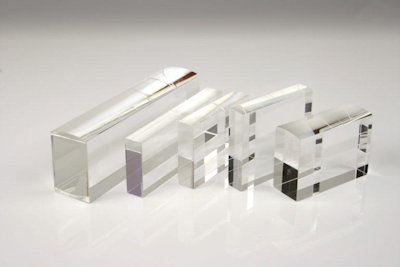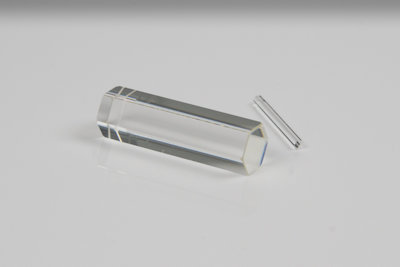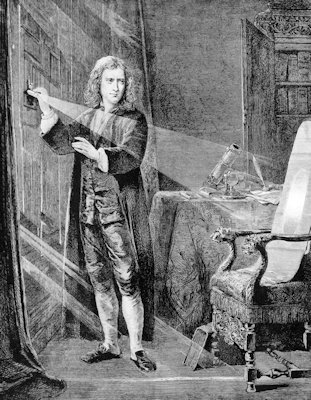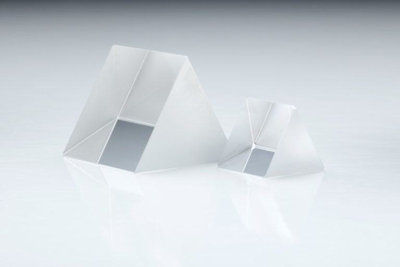In the Spotlight: Light Guides & Prisms
23rd Dec 2021
For this month’s optics spotlight, Knight Optical – the leading supplier of on-spec, metrology-tested and custom-made optical components – groups together two of its most popular optical components. One has long been favoured for high-spec vehicle applications and ultra-precision, laser-based beauty and medical therapies. While the other is perhaps the most widely recognised optic globally, thanks to a little English ’60s music group named Pink Floyd. Of course, the latter refers to the colourful world of Optical Prisms. However, some may be unaware of the former use of Light Guides within the automobile and medical technology sectors. Here, we disclose additional utilisations for these two optics and touch on how researchers are currently pushing their boundaries.

What are Light Guides?
Light Guides also go by an assortment of names. Familiar titles include Lightpipes, Homogenizing Rods and Homogenizers, to name a few. Typically rectangular in shape, these components are designed so that the light travels parallel to their width. Here, light enters through the bottom of the optic and uses the total internal reflection (TIR) to exit through the top edge. Essentially, they are used to increase the uniformity of a light source, and they’re generally used in applications where size restricts the use of a lightbulb. Usually, Light Guides are manufactured in a range of substrates – dependent on the application’s wavelength, of course. By and large, this includes BK7 (or equivalent), UV Fused Silica or Sapphire.
Researchers are now examining 3D approaches to producing Light Guides. For instance, one undertaking explored the prospect of 3D printing geometrically complex Light Guides for scintillation detectors (measuring spectral transmission with a spectrometer). The outcome of the trial found that there was a future ‘potential’ to construct these components for the scintillation detectors. Nevertheless, the study did determine that “continued advancements in materials and methods will likely result in improved optical performance for 3D-printed structures1” (project not pictured). Thus, there could be an opportunity for 3D printing production of selected optics one day in the future. Click here to find out more about this investigation.

What are Light Guides Used For?
There are numerous uses for Light Guides. Perhaps one of the most prominent applications is intense pulsed light (IPL), a laser-like, non-surgical therapy that improves the skin’s colour and texture. Specifically for this application, Light Guides are regularly paired with a Filter to focus a specific waveband onto the skin for treatment.
An alternative district where you can find Light Guides is within the automobile sector, where they’re used for backlighting purposes in indicators and displays, for example. Further operations include biomedical devices, communications equipment, and other illumination systems.

Recent Projects that Have Employed Light Guides
Linking back to the previously mentioned 3D-printed Light Guides development, our following example is also based upon a scintillator (which converts high-energy radiation to near- or visible light) study. On this occasion, the optics were formed in the style of a partition as part of a study to improve light collection efficiency on a ‘pixelated scintillator-based Y-ray imager’2. Here, researchers employed 1mm- and 2mm-thick Light Guides and found that they could “connect both resolution and positional performance improvements to the superior light collection efficiency derived from the 1mm-thick Light Guide2.” You can find the full details of this project here.

Prisms
As noted earlier, Prisms are widely recognised for their feature on Pink Floyd’s ‘Dark Side of the Moon’ album cover. However, we can’t attribute the well-known historical prism experiments to this melodic rock band – as inventive as they were. Science aficionados will know it’s the renowned English Mathematician, Physicist and Astronomer Sir Isaac Newton we must thank for the benefit of Prisms and how we use them today. Of course, Sir Isaac Newton was the first-ever individual to confirm that white light is fabricated of the spectrum of colours that we can see.
What are Prisms?
Now we know more about their origination, let’s explore their formation. Featuring flat surfaces that refract light, standard Prisms are typically used to disperse white light into its component wavelengths. That said, some assortments adjust the placement of an image via displacement, rotation, or deviation of a light beam. These variations are all used for different applications and research-based arrangements, which we’ll explore further below. Specifically at Knight Optical, we offer 13 different styles.
These include (but are not limited to) the following types of Prisms:
- Amici Roof
- Equilateral
- Pellin-Broca
- UV types
- IR types
- Corner Cube
- Fresnel
- Porro
- Wedge
- Deviating Penta
- Reflecting Rhomboid
- Dove
- Littrow
- Right-Angle.

What are Prisms Used For?
These optics are ubiquitous. You can find Prisms everywhere, from periscopes and binoculars to laser-based and beam-combining applications. More specifically, Amici sorts are commonly used as telescope eyepieces, endoscopes, and profile projectors. In contrast, Dove types are valuable to use as image rotators in fields such as astronomy and interferometry.
Recent Projects that Have Employed Prisms
Let’s begin with the Pellin-Broca style. In 2021, this type of Prism was employed in a BK7 substrate, alongside Dielectric Mirrors, for a synchronously-pumped optical parametric oscillator (OPO) – a light source that is like a laser and ordinarily comprises an optical resonator and a non-linear optical crystal. The findings uncovered that this setup produced “wavelengths tuneable across 1100 to 1350 nm, suitable for basic multi-photon applications”. However, the researchers do later note that exchanging the substrate from BK7 to a “less dispersive substrate” like Calcium Fluoride (CaF2) would have provided “smoother tuning” amongst other benefits3. You can learn more about this recent project here.

Moving onto Dove Prisms, these have always been assembled as part of another 2021 study. This time for Free-Space Optical Communication (FSO), where the Dove style was included as part of a system to use a concentric perfect optical vortex (CPOV) beam for data transmission4. Learn more about this study here. Again, Dove Prisms, which are undoubtedly proving popular in spaceborne applications, featured in another off-ground exploration in August last year. Here, they were used
as part of the experiment, ‘A lab proof-of-concept of an extrasolar planet detection using a rotationally shearing interferometer’. In this project, one featured on each of the Mach Zehnder interferometer’s arms5. Read more about this study here.
The Future of Prisms and Light Guides
With such a wide range of uses and realisation within ongoing experiments across many trades, we certainly look forward to seeing what the next year brings for this duo of optical components. Having worked on research projects and mass production of established applications, Knight Optical offers custom-made Prisms and Light Guides as part of a bespoke package. Alongside its comprehensive stock catalogue – of which optics are available for next-day dispatch – Knight Optical’s made-to-order service ensures that all projects’ demands are met, despite the complexity.
Why Choose Knight Optical for your Application?
Discerning customers rely on Knight Optical not only for the premium quality of our output and in-house state-of-the-art Metrology Laboratory and QA Department‘s capabilities but because – as well as a range of Stock Optics (available for next-day dispatch) – we also offer our optics as Custom-Made Components.
Last year, we celebrated 30 years in business. With over three decades’ experience under our belt and a whole host of long-standing world-renowned customers on our books, we are proud to have worked on some of the most ground-breaking innovations.
If you are looking for premium-quality, bespoke optical components, please do not hesitate to get in touch with a member of the Technical Sales Team today.
FOOTNOTES:
1https://www.sciencedirect.com/science/article/abs/pii/S0969804321003754
2https://www.sciencedirect.com/science/article/pii/S1738573321006719
3https://www.osapublishing.org/oe/fulltext.cfm?uri=oe-29-23-37013&id=462460